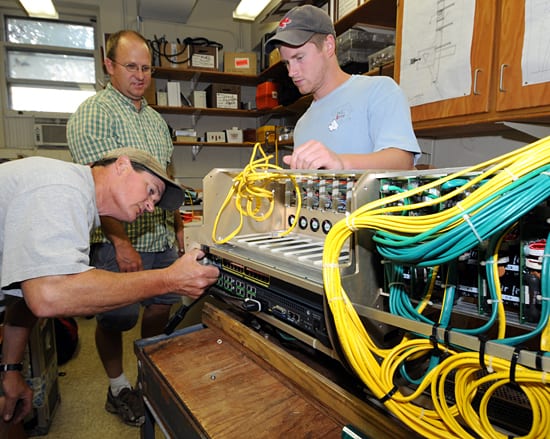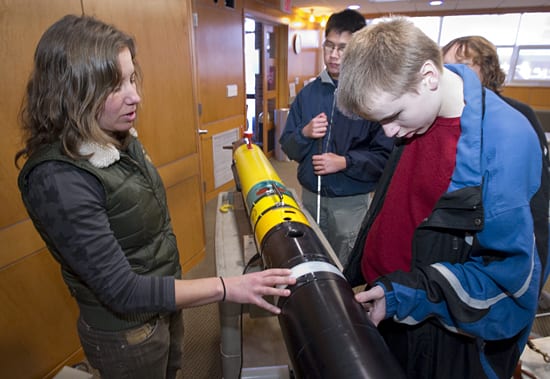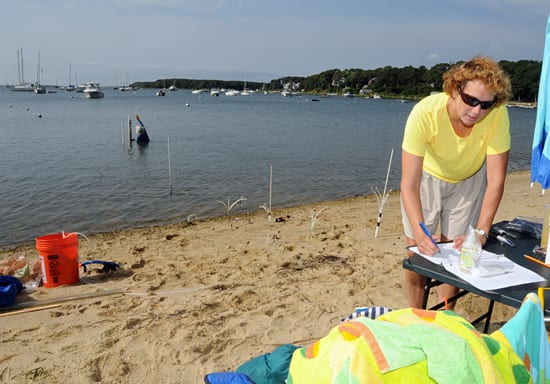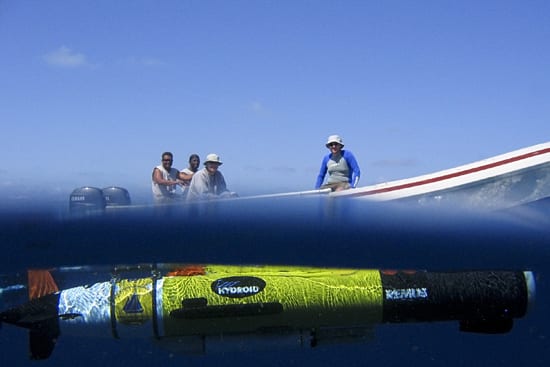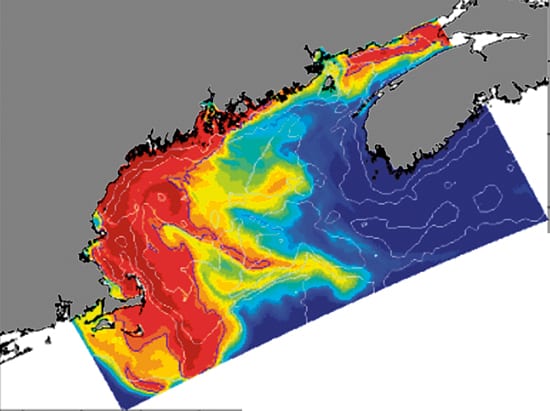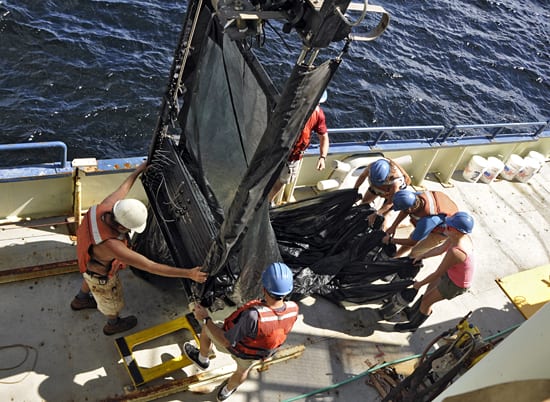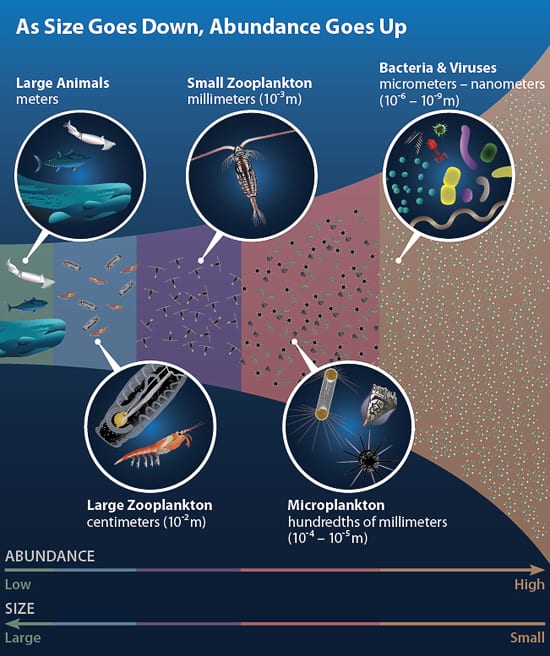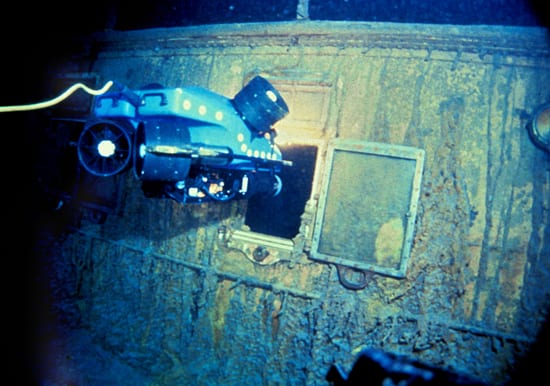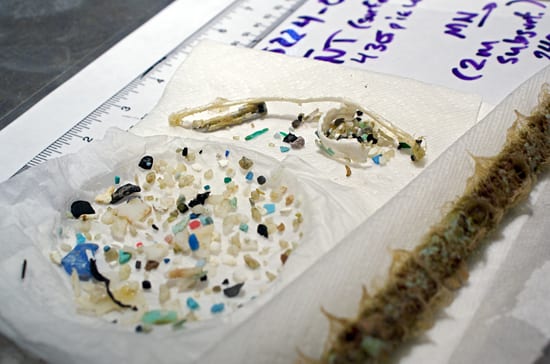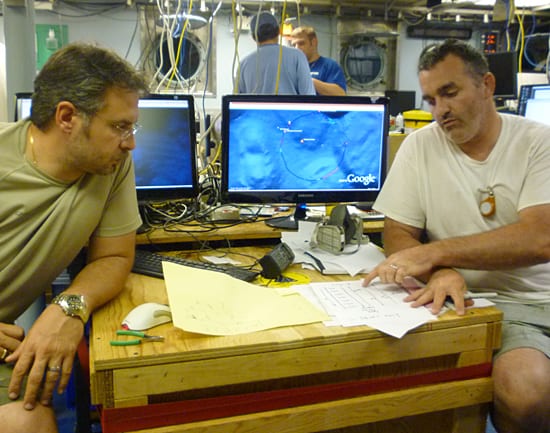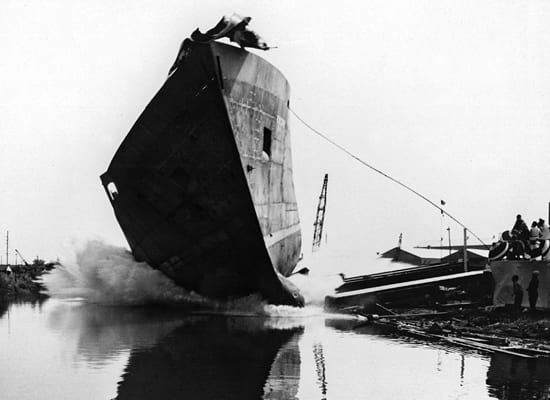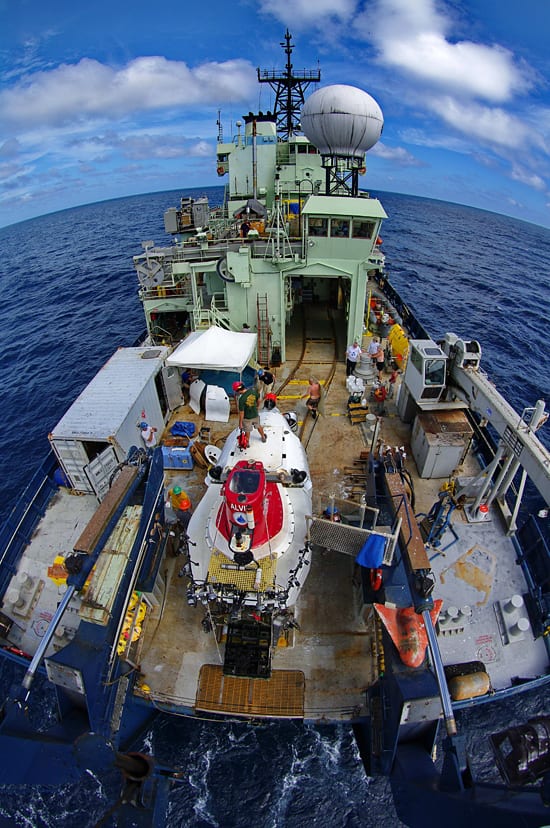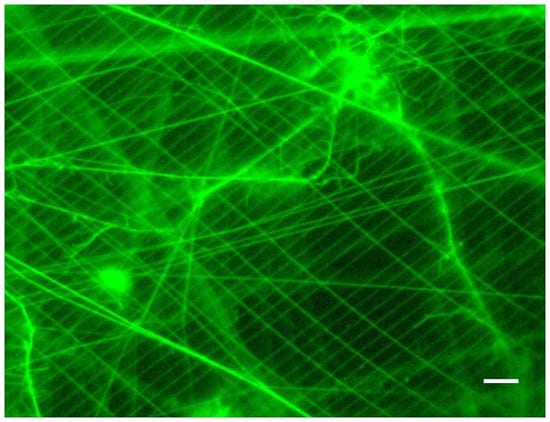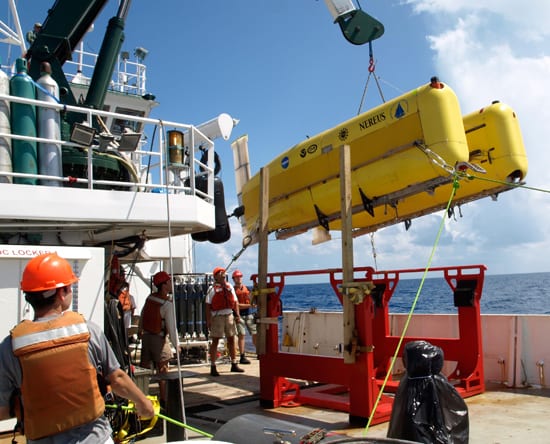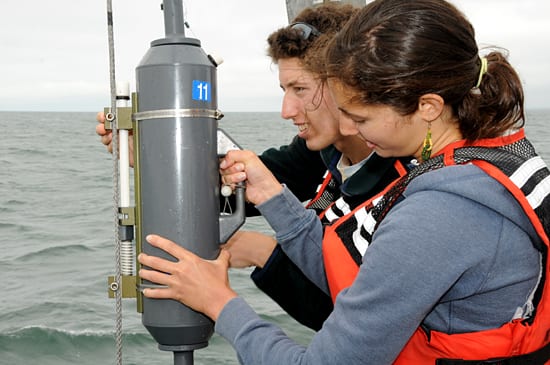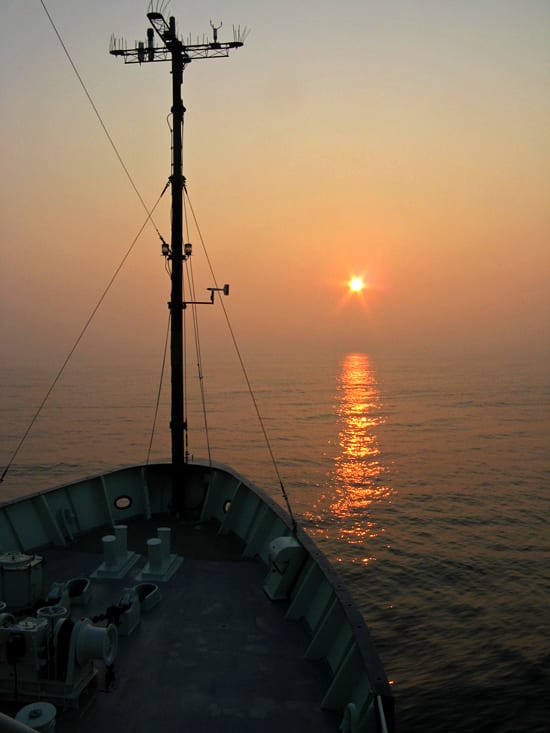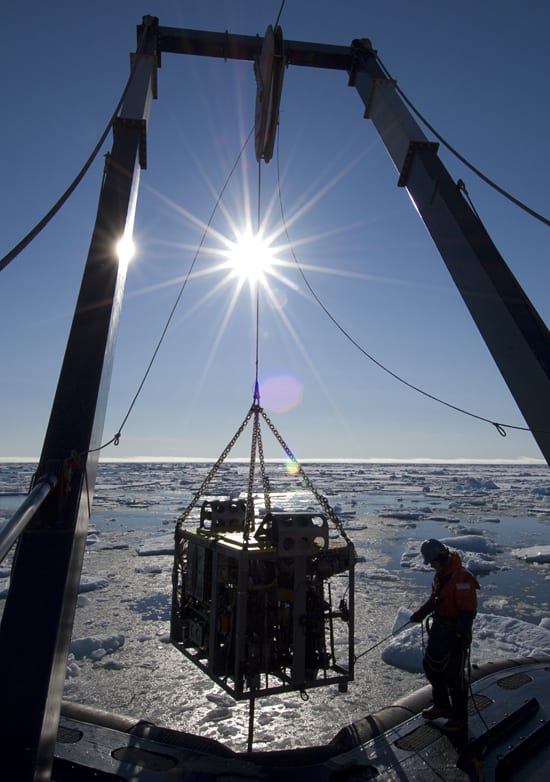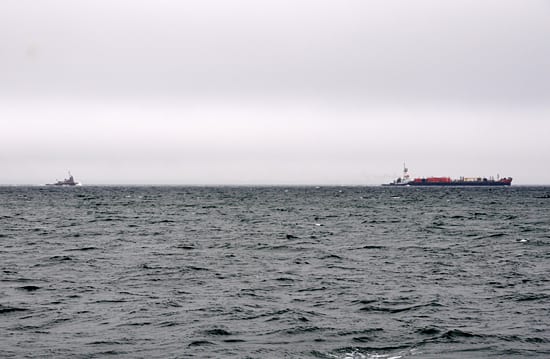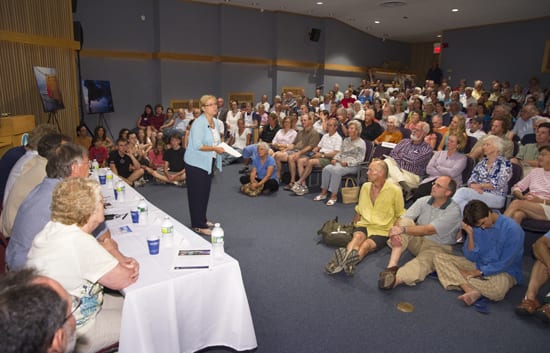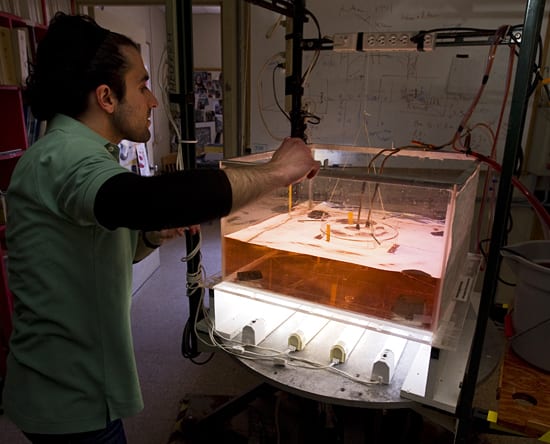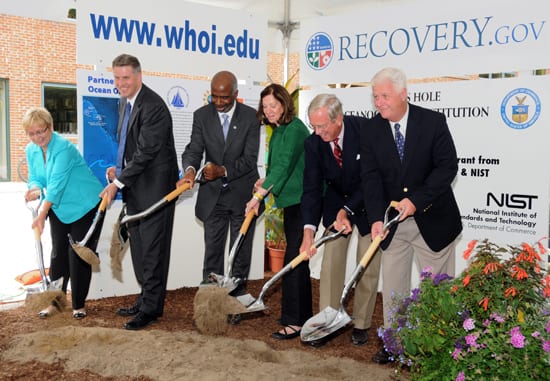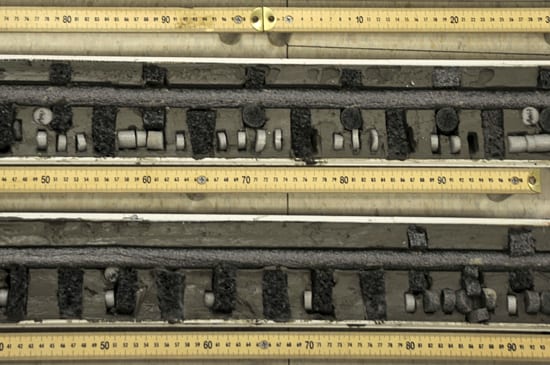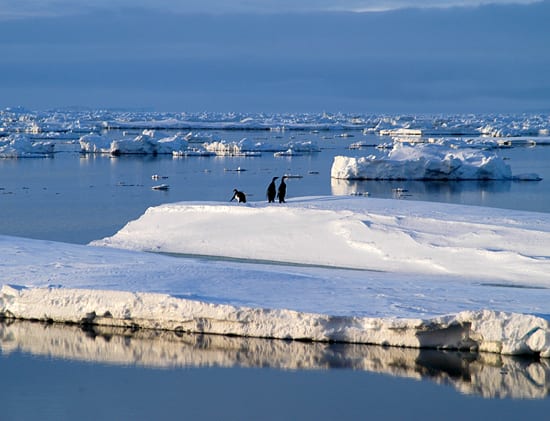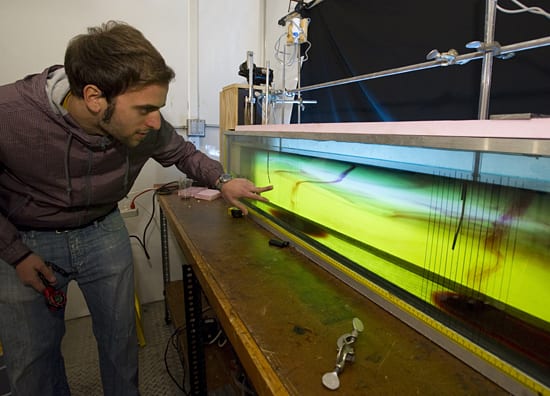Multimedia Items
Maintaining Ocean Vision
At WHOI’s Martha’s Vineyard Coastal Observatory (MVCO), Jay Sisson, Hugh Popenoe, and Jared Schwartz (left to right) switch out part of a “node,” a device that connects several ocean-monitoring instruments.…
Read MoreHands-on Ocean Science
Engineering technician Amy Kukulya describes one of WHOI’s REMUS robotic vehicles to two students (Garret, foreground, and Kenny, left) from the Perkins School for the Blind in Watertown, Mass. WHOI…
Read MoreDouble Check
At Cape Cod’s Waquoit Bay National Estuarine Research Reserve, 2010 Summer Student Fellow Cristin Luttazi records data as WHOI associate scientist Ann Mulligan (in the water) measures water level, temperature,…
Read MoreTaking a Closer Look
A REMUS autonomous underwater vehicle is released at Glover’s Reef Marine Reserve in Belize as crew members Faegon Villanueva and Tyrone Lambert and WHOI researchers Glen Gawarkiewicz and Harvey Walsh…
Read MoreHarmful Algae & Red Tide Research
WHOI scientists Dennis McGillicuddy and Ruoying He created a computer simulation of the historic 2005 toxic algae bloom in New England. Red denotes high algae concentrations; blue the lowest. Algal cells germinated from cyst beds in the Bay of Fundy and along the Maine coast. They were swept south and west by currents. McGillicuddy and He entered a range of factors into their model: the speeds and directions of ocean currents, water temperature and salinity, winds, surface heat exchanges, tides, river runoff, and the distribution and behavior of cells in the water and in seafloor sediments. (Data visualization by Ruoying He and Dennis McGillicuddy, Woods Hole Oceanographic Institution)
Read MoreMultiple Hands for a Multiple Net
Problem: how to find small drifting animals (zooplankton) in the ocean. Solution: tow a net to catch them. Bigger problem: how to determine which animals live at what depth without…
Read MoreSizing Up Sea Life
The ocean is full of life—most of it too small for us to see. Marine life ranges from bacteria and viruses, at nanometer scales (10-9m), to whales and other very…
Read MoreExpedition Titanic 2010
In 1985, a WHOI-led team discovered the site of the most fabled shipwreck in history—the RMS Titanic. In 1986, a group returned to examine the wreck in more detail (above).…
Read MoreAn Ocean Full of Plastic
For more than 20 years, scientists and students from the Sea Education Association (SEA) in Woods Hole have been sailing to the same region of the Atlantic Ocean to study…
Read MoreTracing Hydrocarbon Plumes in the Gulf
Yesterday, WHOI researchers Rich Camilli (left), Christopher Reddy (right), and others released a paper in the journal Science describing a deep plume of hydrocarbons they discovered in the Gulf of…
Read MoreKnorr: 42 Years Young
On August 21, 1968, the hull of the R/V Knorr first entered the water in Bay City, Michigan, and has since traveled more than one million miles in the service…
Read MoreHomeward Bound
The end of a cruise with the deep-sea submersible (DSV) Alvin can be almost as busy as the middle. This photo, taken on April 13, 2010 after dive #4618, shows…
Read MoreSalps take a bite out of CO2
Intersecting strands of a salp‘s feeding net glow green, dyed with a fluorescent dye. Salps, jelly-like ocean animals, make nets of mucus and use them to efficiently filter particles from…
Read MoreNo room for error
Casey Machado, Daniel Gomez-Ibanez, Andy Bowen, and James Kinsey carefully lower the new hybrid underwater robotic vehicle Nereus into place in its cradle on the deck of the R/V Cape…
Read MoreWater, water everywhere
2010 WHOI Summer Student Fellows Jacob Izraelevitz and Isabella Arzeno deploy a water sampling bottle from R/V Tioga during the annual expedition on which Student Fellows learn oceanographic sampling and…
Read MoreSunrise, sunset
A beautiful sunset off the bow of R/V Oceanus during a cruise in June 2008. A science team aboard the Oceanus will head to the Gulf of Mexico in late…
Read MoreA happy CAMPER
WHOI engineer John Kemp sends the tethered vehicle CAMPER off on its final mission of the second Polar Discovery expedition. CAMPER was specially built to allow scientists to image and…
Read MoreTug, tug
A tugboat follows another tugboat pushing a barge through Buzzards Bay, Mass. The Massachusetts Department of Environmental Protection now requires state-dispatched tugboats to escort double-hulled tank vessels carrying 6,000 barrels…
Read MoreWHOI in the Gulf
Susan Avery, president and director of WHOI, welcomes community members to the public forum, “WHOI in the Gulf of Mexico,” held on July 29, 2010. A 5-member panel of scientists…
Read MoreStudying ocean flow, from Rome to WHOI
Domenico Mussardo, a guest student from the University of Rome “La Sapienza”, spent spring 2010 at WHOI working with Claudia Cenedese, who studies ocean currents with laboratory experiments using tanks…
Read MoreBreaking ground
Equipped with an $8.1 million federal Recovery Act grant and shiny, new shovels, the Woods Hole Oceanographic Institution (WHOI) celebrated the groundbreaking of its new Laboratory for Ocean Sensors and…
Read MoreSlices of history
A little goes a long way in sediment cores, but there’s not much left of this one laid out horizontally in a case. Seafloor sediment accumulates slowly as dead organisms…
Read MoreSouthern Ocean sentinel
Daniel Bogorff of the Subsurface Mooring Operations Group snapped this image of penguins while on the R/V Aurora Australis enroute to Casey Station in Antarctica. The focus of the expedition,…
Read MoreColorful experiment
Guest Student Alessandro Ramoni conducts a “fjord experiment” in WHOI’s geophysical fluid dynamics laboratory. Ramoni, from the University of Rome “Tor Vergata”, worked with WHOI scientists Claudia Cenedese and Fiammetta…
Read More
